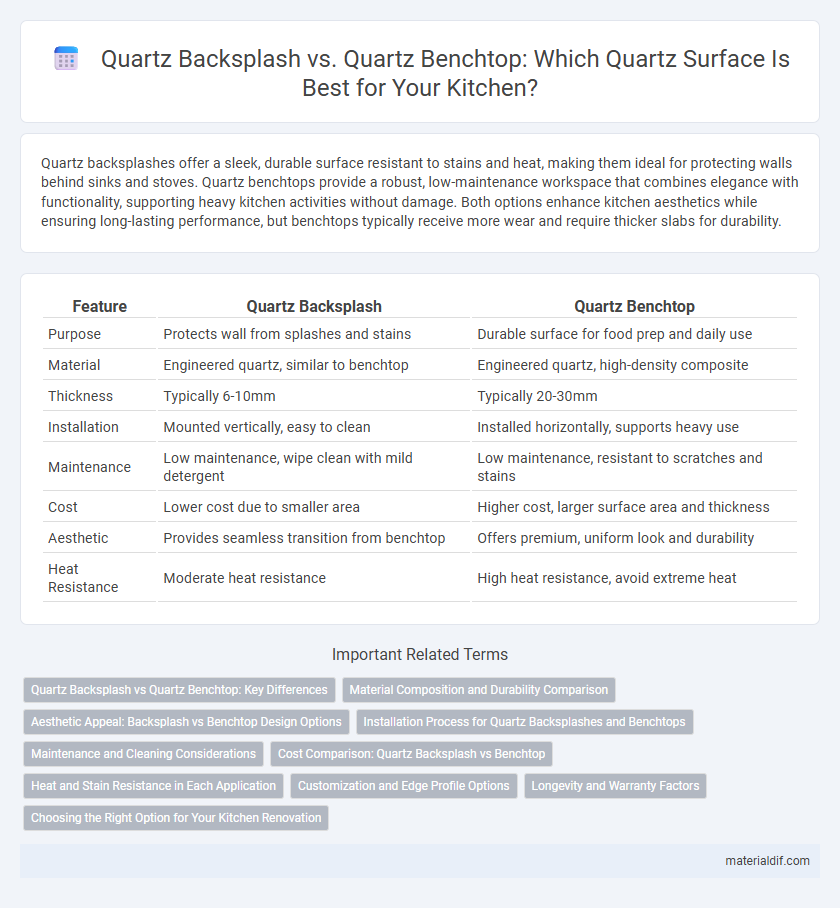Quartz backsplashes offer a sleek, durable surface resistant to stains and heat, making them ideal for protecting walls behind sinks and stoves. Quartz benchtops provide a robust, low-maintenance workspace that combines elegance with functionality, supporting heavy kitchen activities without damage. Both options enhance kitchen aesthetics while ensuring long-lasting performance, but benchtops typically receive more wear and require thicker slabs for durability.
Table of Comparison
| Feature | Quartz Backsplash | Quartz Benchtop |
|---|---|---|
| Purpose | Protects wall from splashes and stains | Durable surface for food prep and daily use |
| Material | Engineered quartz, similar to benchtop | Engineered quartz, high-density composite |
| Thickness | Typically 6-10mm | Typically 20-30mm |
| Installation | Mounted vertically, easy to clean | Installed horizontally, supports heavy use |
| Maintenance | Low maintenance, wipe clean with mild detergent | Low maintenance, resistant to scratches and stains |
| Cost | Lower cost due to smaller area | Higher cost, larger surface area and thickness |
| Aesthetic | Provides seamless transition from benchtop | Offers premium, uniform look and durability |
| Heat Resistance | Moderate heat resistance | High heat resistance, avoid extreme heat |
Quartz Backsplash vs Quartz Benchtop: Key Differences
Quartz backsplashes provide a protective vertical barrier against spills and stains, often located behind sinks and stoves, enhancing kitchen aesthetics with seamless continuity when matched with quartz benchtops. Quartz benchtops serve as durable, scratch-resistant work surfaces designed to withstand heavy daily use, offering structural integrity and easy maintenance. The key differences lie in their functional roles, installation areas, and exposure to wear, with benchtops requiring thicker slabs for durability compared to the thinner quartz material used in backsplashes.
Material Composition and Durability Comparison
Quartz backsplashes and quartz benchtops both comprise engineered stone with approximately 90-95% natural quartz combined with resins and pigments, ensuring consistent durability. The benchtop typically undergoes enhanced fabrication processes like polishing and sealing to withstand heavy impact, heat, and scratches, while backsplashes prioritize smooth finishes with moderate impact resistance due to less direct use. Both surfaces offer exceptional non-porous qualities, but benchtops are specifically treated to endure more rigorous daily wear in kitchen environments.
Aesthetic Appeal: Backsplash vs Benchtop Design Options
Quartz backsplashes offer a streamlined and cohesive aesthetic by seamlessly extending the quartz material vertically, creating a unified look with quartz benchtops. Benchtops provide a broader canvas with varied color patterns and textures, allowing for bold statements or subtle elegance in kitchen design. Choosing between the two depends on the desired visual impact, with backsplashes enhancing vertical continuity and benchtops serving as the primary focal point.
Installation Process for Quartz Backsplashes and Benchtops
Quartz backsplashes and benchtops share a similar installation process involving precise measurement, cutting, and adhesive application, but backsplashes require additional attention to vertical alignment and secure anchoring to walls. The installation of quartz benchtops demands careful leveling and support to withstand countertop use, often necessitating professional assistance for cutouts like sinks and cooktops. Both surfaces benefit from sealed edges and joint treatments to prevent moisture infiltration and ensure durability in kitchen environments.
Maintenance and Cleaning Considerations
Quartz backsplashes require minimal maintenance, needing only regular wiping to prevent water spots and splashes from hard water or cooking oils. Quartz benchtops also offer low maintenance but demand immediate cleaning of spills like acidic substances to avoid potential etching or staining. Both surfaces benefit from using mild soap and a soft cloth, avoiding abrasive cleaners to preserve their polished finish and long-term durability.
Cost Comparison: Quartz Backsplash vs Benchtop
Quartz backsplashes generally cost less per square foot than quartz benchtops due to thinner material requirements and less surface area coverage. Installation fees for backsplashes are typically lower because of simpler cutting and fitting compared to benchtops, which demand precise edge finishing and durability standards. While quartz benchtops offer higher durability and functionality, the cost difference typically ranges from 20% to 40% more compared to backsplashes, impacting total renovation budgets significantly.
Heat and Stain Resistance in Each Application
Quartz backsplashes and benchtops both offer exceptional stain resistance due to their non-porous surfaces, making them ideal for kitchen environments prone to spills and splashes. Heat resistance, however, is more critical for quartz benchtops, as they are directly exposed to hot pots and pans; while quartz can handle moderate heat, sudden temperature changes may cause discoloration or damage. In contrast, quartz backsplashes are less vulnerable to heat exposure, allowing their stain-resistant qualities to be the primary benefit in protecting walls from splatters and moisture.
Customization and Edge Profile Options
Quartz backsplashes and benchtops both offer extensive customization options, including a wide range of colors, patterns, and finishes tailored to specific design preferences. Edge profile options for quartz benchtops are more varied, featuring popular styles such as beveled, bullnose, and ogee, allowing for a personalized and elegant finish. Quartz backsplashes typically have simpler edge profiles, prioritizing seamless installation and easy maintenance in kitchen and bathroom environments.
Longevity and Warranty Factors
Quartz backsplashes and quartz benchtops both offer exceptional durability due to their dense, non-porous surface that resists stains, scratches, and heat. Quartz benchtops typically come with more comprehensive warranties, often ranging from 10 to 25 years, reflecting their frequent use and higher exposure to wear and tear. Longevity for backsplashes is generally higher since they face less direct impact, allowing for extended warranties and reduced maintenance compared to benchtops.
Choosing the Right Option for Your Kitchen Renovation
Quartz backsplashes offer a seamless, easy-to-clean surface that resists stains and heat, making them ideal for protecting walls behind sinks and stoves. Quartz benchtops provide durability and a sleek, modern appearance with high resistance to scratches and impacts, serving as a functional workspace. Selecting between quartz backsplash and benchtop depends on your kitchen's design priorities, maintenance preferences, and budget considerations.
Quartz Backsplash vs Quartz Benchtop Infographic

 materialdif.com
materialdif.com